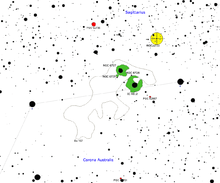NGC 6723
| NGC 6723 | |
|---|---|
|
| |
| Observation data (J2000 epoch) | |
| Class | VII[1] |
| Constellation | Sagittarius |
| Right ascension | 18h 59m 33.15s[2] |
| Declination | –36° 37′ 56.1″[2] |
| Distance | 28.4 kly (8.7 kpc)[3] |
| Apparent magnitude (V) | 6.8[4] |
| Apparent dimensions (V) | 11′[4] |
| Physical characteristics | |
| Mass | 3.57×105[3] M☉ |
| Metallicity | = –0.96[5] dex |
| Estimated age | 13.06 Gyr[5] |
NGC 6723 is a globular cluster[6] in the constellation Sagittarius. Its magnitude is given between 6 and 6.8, and diameter between 7 and 11 arcminutes, class VII with stars magnitude 14 and dimmer. It is near the border of Sagittarius and Corona Australis.

Map showing location of NGC 6723 (Roberto Mura)
References
- ↑ Shapley, Harlow; Sawyer, Helen B. (August 1927), "A Classification of Globular Clusters", Harvard College Observatory Bulletin (849): 11–14, Bibcode:1927BHarO.849...11S.
- 1 2 Goldsbury, Ryan; et al. (December 2010), "The ACS Survey of Galactic Globular Clusters. X. New Determinations of Centers for 65 Clusters", The Astronomical Journal, 140 (6): 1830–1837, arXiv:1008.2755
 , Bibcode:2010AJ....140.1830G, doi:10.1088/0004-6256/140/6/1830.
, Bibcode:2010AJ....140.1830G, doi:10.1088/0004-6256/140/6/1830. - 1 2 Boyles, J.; et al. (November 2011), "Young Radio Pulsars in Galactic Globular Clusters", The Astrophysical Journal, 742 (1): 51, arXiv:1108.4402
 , Bibcode:2011ApJ...742...51B, doi:10.1088/0004-637X/742/1/51.
, Bibcode:2011ApJ...742...51B, doi:10.1088/0004-637X/742/1/51. - 1 2 "Data for NGC 6723". NGC/IC Project. Retrieved 19 November 2013.
- 1 2 Forbes, Duncan A.; Bridges, Terry (May 2010), "Accreted versus in situ Milky Way globular clusters", Monthly Notices of the Royal Astronomical Society, 404 (3): 1203–1214, arXiv:1001.4289
 , Bibcode:2010MNRAS.404.1203F, doi:10.1111/j.1365-2966.2010.16373.x.
, Bibcode:2010MNRAS.404.1203F, doi:10.1111/j.1365-2966.2010.16373.x. - ↑ "SIMBAD Astronomical Object Database". Results for NGC 6723. Retrieved 2007-04-21.
- Robert Burnham, Jr, Burnham's Celestial Handbook: An observer's guide to the universe beyond the solar system, vol 3, p.1558
External links
- NGC 6723 on WikiSky: DSS2, SDSS, GALEX, IRAS, Hydrogen α, X-Ray, Astrophoto, Sky Map, Articles and images
- NGC 6723
Coordinates: ![]() 18h 59m 33.1s, −36° 37′ 53.3″
18h 59m 33.1s, −36° 37′ 53.3″
This article is issued from Wikipedia - version of the 12/3/2016. The text is available under the Creative Commons Attribution/Share Alike but additional terms may apply for the media files.
